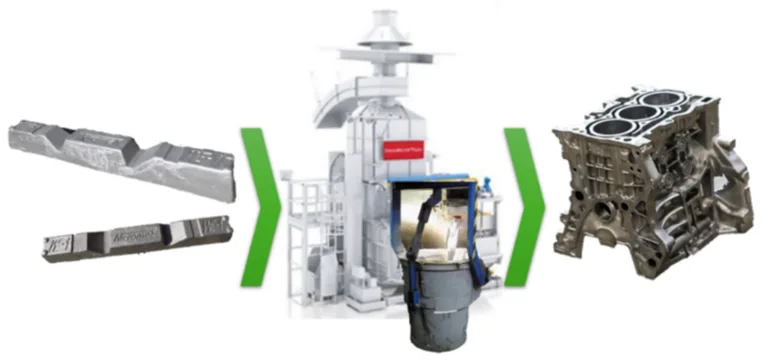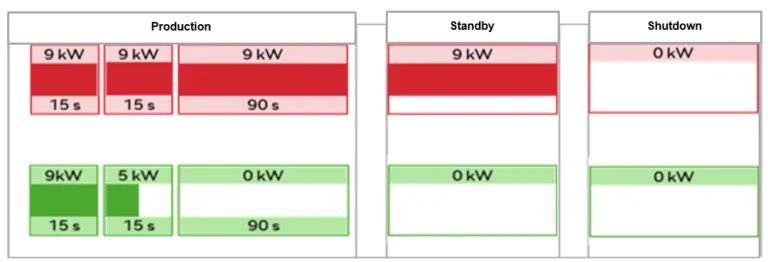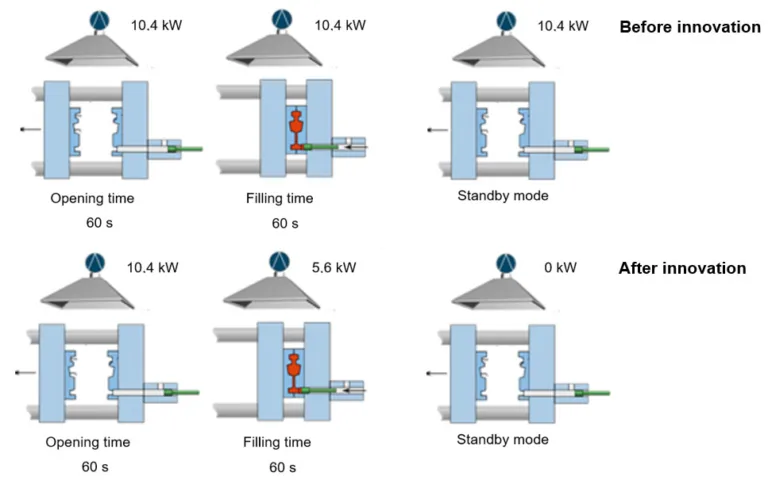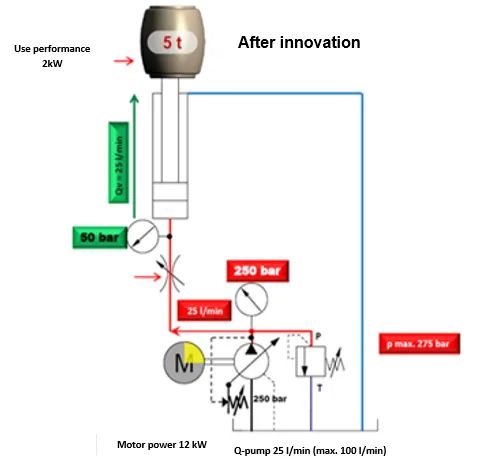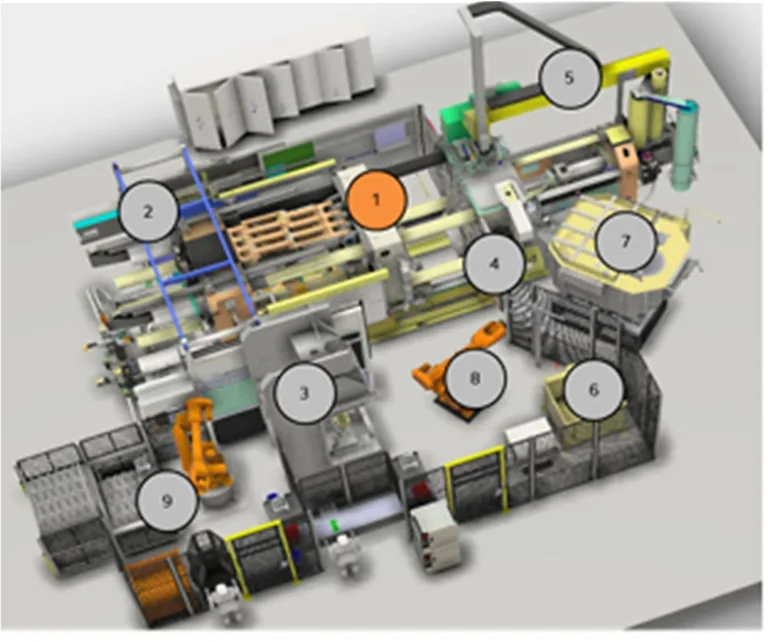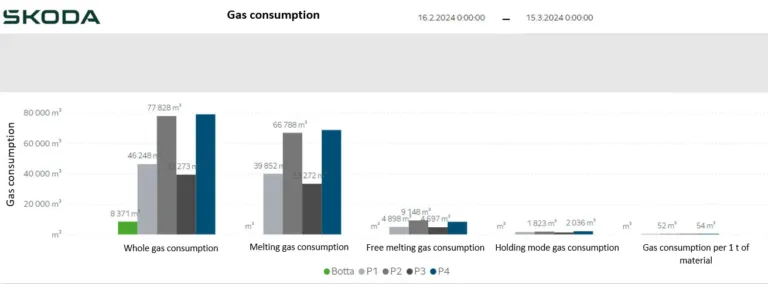本紹介論文は、「Rocznik Ochrona Środowiska」によって発行された論文「Green Innovations in Foundry Production Processes of Automobile Castings」に基づいています。
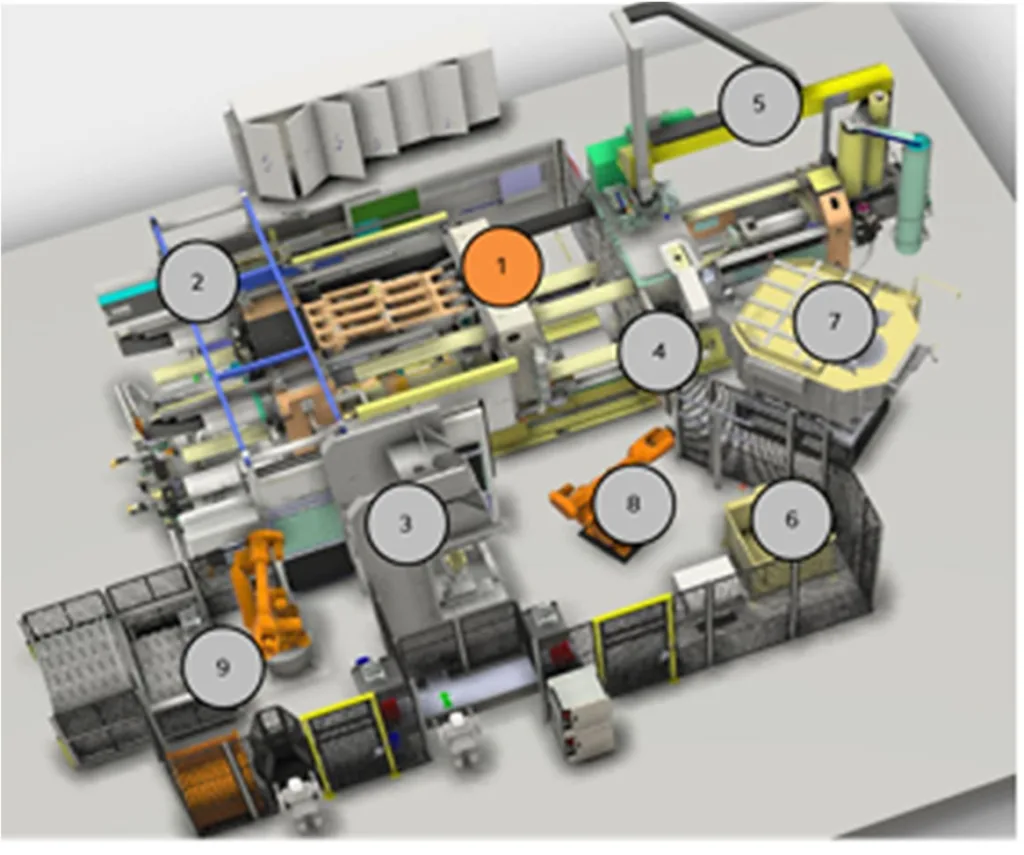
1. 概要:
- 論文名 (Title): Green Innovations in Foundry Production Processes of Automobile Castings
- 著者 (Author): Josef Bradáč, Martin Folta, Jiří Machuta, Jiří Slabý, Michal Beneš
- 発行年 (Year of publication): 2024
- 発行元ジャーナル/学会 (Journal/academic society of publication): Rocznik Ochrona Środowiska
- キーワード (Keywords): foundry, innovations, energy savings, environmental impact
2. 抄録:
本論文は、自動車部品の生産におけるエネルギー節約と化学物質使用に関する個々の可能性を扱っています。具体的には、エンジンブロックやギア・クラッチハウジングのような形状が複雑な鋳造品を high-pressure die-casting technology を用いて生産するアルミニウム鋳造工場の操業に焦点を当てています。生産プロセスに関して、鋳造作業は高いエネルギー消費と大量の廃水発生を特徴とします。一方で、様々なイノベーションを導入し、節約を追求する大きな可能性も存在します。本論文は、鋳造作業全体にわたる選ばれた革新的なソリューションを提示し、エネルギー消費節約、廃水生産削減、化学物質使用量削減におけるそれらの利点を評価することを目的としています。提示された節約の影響は、部品生産に関する財務面と、CO2 production に関する環境面の両方で評価されます。
3. 序論:
今日、環境保護への関心が高まっており、人間のあらゆる活動分野に関連する有害物質の生産を削減する一般的な取り組みが進んでいます。これは産業部門(Lenort et al. 2019, Gabrylewicz et al. 2021)および一般の工業生産にも当てはまります。green production(Saetta & Caldarelli 2020)や都市および関連するグリーンロジスティクス(Sharma et al. 2023, Chamier-Gliszczynski 2012)といった新しいトレンドがここで適用されています。廃棄物を最小限に抑え、回収し、廃棄物管理システムを構築する圧力もあります(Espuny et al. 2022, Ignatowicz et al. 2021)。製品ライフサイクル全体(LCA)を通じてすべての活動を監視・評価するという包括的なアプローチを適用することも重要です(Bajdur et al. 2023, Chamier-Gliszczynski & Krzyzynski 2005)。生産性と効率性に対する高い要求を持つ現代の工業生産は、現在、エネルギー資源面での節約を見つけることに非常に注力しています。あらゆる種類のエネルギーにおけるエネルギー節約の達成(Kuczynski et al. 2021)は、効率的で環境に優しい工業生産の要件を満たすための必須条件です(Orłowska 2022, Jenek, et al. 2022)。次のトレンドは、プロセスのデジタル化と Industry 4.0 です(Ghadge et al. 2022, Menti et al. 2023, Kostrzewski et al. 2020)。デジタル化は、プロセス効率を向上させる多くの機会をもたらします(Szajna et al. 2021)。デジタル形式の大量の生産データのおかげで、特定の傾向を監視したり、効率向上のために導入されたイノベーションのプラスの影響レベルを評価し、ひいては環境への影響を削減したりすることが可能です。
自動車産業は、非常にダイナミックな発展、大きな革新的可能性、およびイノベーションパフォーマンスを特徴とする複雑で特殊な産業です(Mir et al. 2022, Nawrocki et al. 2018)。また、高いレベルの標準化と、結果として得られる製品の品質に対する要求の高まりもあります(Sumasto et al. 2023)。自動車製造は複雑であり、多くの特定の生産技術とプロセスを伴います。目標は、必要な品質を維持しながら、最短時間かつ最小コストで最終製品を設計、製造、顧客に納入することです。これは、すべての生産プロセスと関連するロジスティクスプロセスにおける絶え間ない革新と最適化への注力なしには不可能です(Scharf et al. 2022, Staniuk et al. 2022)。これは特に、鋳造工場のような高いエネルギーと燃料消費を伴う生産分野に当てはまります。したがって、冶金部門全般において、様々な節約と生産コスト削減およびプロセス最適化の大きな可能性があります(Obzina et al. 2021)。自動車産業の場合、鋳造工場は主に内燃機関やギアボックスの部品を生産します。鋳造品を生産するための基本材料は、軽量性や耐食性などの有利な機械的特性を示すアルミニウム合金です。High-pressure die casting は、高い生産性を可能にし、複雑な薄肉鋳造品の生産に適した技術です。しかし、望ましい特性を達成するためには、プロセスパラメータの正しい設定と制御が必要です(Ťavodová et al. 2022)。これには、個々の生産機械のプロセスパラメータを監視し、このデータをデジタル形式で使用するシステムを適用することも含まれます。同様に、プロセス全体で発生する損失やプロセス流体の消費を監視し、その後特定することが可能です。廃熱レベルが高い領域をより良く特定できれば、熱損失レベルをより効率的に削減できます(Samtleben et al. 2021)。これには、生産設備の最適な配置と鋳造工場内の効率的なマテリアルフローも必要です(Scharf et al. 2021)。本稿の以下の部分は、自動車鋳造品の鋳造生産プロセスにおけるグリーンイノベーションに焦点を当てています。この記事は、エネルギーと作動物質の消費を削減し、それによって鋳造作業の環境への影響を低減することを目的とした Škoda Auto 鋳造工場における選ばれたイノベーションを提示することを目的としています。
4. 研究の概要:
研究テーマの背景:
自動車部品(エンジンブロック、ギア/クラッチハウジングなど)向けのアルミニウム high-pressure die casting を中心とする鋳造作業は、本質的に energy-intensive であり、大量の natural gas, electricity, compressed air, industrial water を消費します。また、廃水を生成し、化学物質の使用を必要とします。同時に、環境保護、効率向上、コスト削減に対する業界からの強い圧力があります。
先行研究の状況:
工業生産における一般的なトレンドには、green production 原則の実施、waste management systems、life cycle assessments (LCA)、あらゆるエネルギータイプにわたる energy savings の達成、プロセス効率の監視と改善のための digitization と Industry 4.0 の活用が含まれます。自動車産業は特に、複雑な製造プロセスにおける innovation, standardization, quality, cost optimization に焦点を当てています。研究は、鋳造工場を含む冶金部門内での節約と最適化の可能性を強調しています。
研究の目的:
本論文は、Škoda Auto アルミニウム鋳造工場の操業全体で実施された選ばれた革新的なソリューションを提示し、energy consumption savings, reduced wastewater production, chemicals usage に関するそれらの利点を評価することを目的としています。また、これらの節約の財務的および環境的(CO2 production)影響も評価します。
研究の核心:
本研究は、high-pressure die-casting technology を使用する Škoda Auto アルミニウム鋳造工場で実施された特定のグリーンイノベーションに焦点を当てています。natural gas(furnace lining renovation)、electricity(casting machines の frequency converters、optimized extraction systems、efficient cutting press controls、annealing furnaces からの waste heat recovery、LED lighting)、industrial water(micro-spraying mould treatment、optimized cooling circuits)、chemicals(冷却水用の automated dosing)の消費を削減するために実施されたソリューションを詳述しています。本論文は、これらのイノベーションによって達成された節約を定量化し、プロセス効率と環境フットプリントへの影響を議論します。
5. 研究方法論
研究デザイン:
本研究は、稼働中の自動車鋳造工場(Škoda Auto)内で実施された特定の技術革新を詳述する一連のケーススタディを提示します。問題、実施されたソリューション(イノベーション)、および結果として得られた利点を概説する、記述的かつ評価的なアプローチを採用しています。
データ収集・分析方法:
データは、イノベーション実施前後のエネルギーおよび資源消費を監視することによって収集されました。これには、デジタル監視システム(例:Fig. 2 に示すガス消費に関する Power BI レポート、およびセクション 4.2 で言及されている水消費監視)および直接測定の使用が含まれます。分析には、消費データの比較(例:Tables 1-4)、エネルギー節約量(kWh/year, m³/year)の計算、水および化学物質使用量の削減の定量化、プロセスパラメータ(例:サイクルタイム、効率)および環境要因(CO2 reduction)への影響の評価が含まれます。3D Trasar オンラインデバイスは、連続的な水分析と冷却水への化学物質の自動投与に使用されました(Fig. 10)。
研究対象と範囲:
本研究は、Škoda Auto のアルミニウム鋳造生産プロセスに範囲を限定し、特に自動車部品(エンジンブロック、ギアボックス、クラッチハウジング)の high-pressure die casting に焦点を当てています。調査されたトピックは、natural gas, electricity, industrial water, chemicals の消費を削減し、それによってエネルギー効率を改善し、環境への影響を低減することを目的とした、実施された特定のイノベーションです。
6. 主要な結果:
主要な結果:
本研究は、様々なイノベーションを通じて大幅な節約を実証しました:
- Natural Gas: furnace lining の改修により、年間 natural gas 消費量が 584 m³/year 削減され、コスト削減と CO2 削減に貢献し、溶解時間も短縮されました。
- Electricity (鋳造職場):
- 鋳造機油圧回路への frequency converters の適用により、年間 257,852 kWh の電力を節約しました (Table 2)。
- 最適化された extraction system 制御により、年間 35,224 kWh の電力を節約しました (Table 3)。
- 新しい cutting press 制御により、年間 48,738 kWh の電力を節約しました (Table 4 から計算: 60480 - 11742)。
- Electricity (一般):
- annealing furnaces からの waste heat recovery を利用した工場暖房により、冬季に年間 691,000 kWh の電力を節約しました。焼鈍温度の最適化(250°C から 210°C)も、品質に影響を与えることなく消費電力削減に貢献しました。
- 従来の照明を蛍光灯および LED lamps に交換することで、2022 年に 2680 MWh の電力を節約しました。
- Water and Chemicals:
- Overall: Digitization とデータ監視(例:Power BI)は、潜在的な節約を特定し、イノベーションの影響を評価し、損失を最小限に抑える上で重要でした。
図のリスト (Figure Name List):
- Fig. 1. The procedure of cylinder block production, from molten metal to final product
- Fig. 2. Power BI report of gas consumption in individual melting devices for a selected period
- Fig. 3. Melting furnace with an example of an inner lining of the melting space
- Fig. 4. Schematic view of individual devices in the casting workplace: (1 – high pressure casting machine, 2 – machine extraction, 3 – cutting press, 4 – data matrix code punch, 5 – foundry mould treatment manipulator, 6 – cooling bath, 7 – holding furnace, 8 – handling robot, 9 – robotic, automatic palletizing)
- Fig. 5. Control status of the casting machine hydraulic circuit before and after applying the frequency converter
- Fig. 6. Comparison of energy consumption of an extraction system, before (top) and after (bottom)
- Fig. 7. Graphical representation of the innovation concerning savings of the cutting press, before (red), after application of the innovation (green)
- Fig. 8. Situation before and after the implementation of waste heat recovery system from annealing furnaces
- Fig. 9. Transition from the old type of lighting on the left to the modern type of LED lamps on the right
- Fig. 10. Transition from manual water sampling and manual laboratory analysis to the use of the 3D Trasar online equipment for precise analysis and dosing of chemical products to be used in the cooling water
7. 結論:
自動車産業は、車両の運用と生産の両方において、より高い効率とより低い環境影響をますます重視しています。鋳造工場は、energy-intensive であり、高温の材料を扱うため、これらの目標達成には課題がありますが、energy savings の大きな可能性を秘めています。効果的なイノベーションを実施するには、潜在的可能性の正しい特定、利点の評価(財務面とダウンタイムを含む)、および慎重な計画が必要です。本論文で提示されたソリューション(furnace lining renovation、鋳造職場におけるエネルギー効率対策、waste heat recovery、照明のアップグレード、micro-spraying、最適化された水処理)は、より持続可能で環境に優しい部品生産に向けた個々のステップを表しており、energy savings と CO2 reduction に貢献します。Digitization とデータ評価は、プロセスを監視し、損失を特定し、イノベーションの影響を最大化するための重要な推進力として強調されています。本論文は、金型への 100% micro-spraying の使用と、すべてのプロセス物質の潜在的な漏洩の毎日の監視および削減(少なくとも)を、必ずしも多額の初期投資を必要とせずに、実質的な環境上の利点をもたらす対策として推奨しています。
8. 参考文献:
- [参考文献リストは英語原文のまま記載します]
- Bajdur, W., Zielińska, A., Gronba-Chyła, A. (2023). Product Life Cycle Assessment (LCA) as a Tool for Environmental Management. Rocznik Ochrona Środowiska, 25(1), 389-398.
- Chamier-Gliszczynski, N., Krzyzynski, T. (2005). On modelling three-stage system of receipt and automotive recycling. REWAS'04, Global Symposium on Recycling, Waste Treatment and Clean Technology 2005, 2813-2814, Madrid, Spain, 26-29 September 2004, Conference Paper, ISBN: 8495520060.
- Chamier-Gliszczyński, N. (2012). Modeling system mobility in urban areas. Congress Proceedings, CLC 2012: Carpathian Logistics Congress, 501-508, 111467.
- Espuny, M., Costa, A.C.F., Reis, J.S.M., Barbosa, L.C.F.M, Snatos, R.C.G., Oliveira, O.J. (2022). Identification of the Elements and Systematisation of the Pillars of Solid Waste Management. Quality Innovation Prosperity, 26(2), 147-169.
- Gabrylewicz, I., Lenort, R., Wędrychowski, M., Krupa, P., Woźniak, W. (2021). Environmental Loads Resulting from Manufacturing Technology. Rocznik Ochrona Srodowiska, 23, 613-628. https://doi.org/0.54740/ros.2021.043
- Ghadge, A., Mogale, D.G., Bourlakis, M., Maiyar, L.M., Moradlou, H. (2022). Link between Industry 4.0 and green supply chain management: Evidence from the automotive industry. Computers & Industrial Engineering, 169(1), 1-14.
- Ignatowicz, K., Piekarski, J., Kogut, P. (2021). Influence of selected substrate dosage on the process of biogas installation start-up in real conditions. Energies, 14(18), 5948. https://doi.org/10.3390/en14185948
- Jenek, M., Ociepa, M., Woźniak, W., Vilmová, Š., Švecová, E. (2022). Rocznik Ochrona Srodowiska, 24, 360-370. https://doi.org/10.54740/ros.2022.025
- Kostrzewski, M., Chamier-Gliszczynski, N., Królikowski, T. (2020). Selected reflections on formal modeling in Industry 4.0. Procedia Computer Science, 176, 3293-3300. https://doi.org/10.1016/j.procs.2020.09.118
- Kuczynski, W., Kaminski, K., Znaczko, P., Chamier-Gliszczynski, N., Piatkowski, P. (2021). Features and Thermal Efficiency of Flat-Plate Solar Collectors. Energies, 14(2), 261. https://doi.org/10.3390/en14020261
- Lenort, R., Baran, J., Wysokinski, M., Golasa, P., Bienkowska-Golasa, W., Golonko, M., Chamier-Gliszczynski, N. (2019). Economic and Environmental Efficiency of the Chemical Industry in Europe in 2010-2016. Rocznik Ochrona Srodowiska, 21(2), 1393-1404.
- Menti, F., Romero, D., Jacobsen, P. (2023). A technology assessment and implementation model for evaluating socio-cultural and technical factors for the successful deployment of Logistics 4.0 technologies. Technological Forecasting and Social Change, 190(1), 1-17.
- Mir, M., Llach, J., Casadesus, M. (2022). Degree of Standardization and Innovation Capability Dimensions as Driving Forces for Innovation Performance. Quality Innovation Prosperity, 26(2), 1-20.
- Nawrocki, W., Stryjski, R., Woźniak, W., Jakubowski, J. (2018). Improving the quality of manufacturing processes in Toyota motor manufacturing, Poland. Proceedings of the 31st International Business Information Management Association Conference, IBIMA 2018: Innovation Management and Education Excellence through Vision 2020, 143853, 5931-5945.
- Obzina T., Merta V., Folta M., Bradáč J., Beňo J., Novohradsaká N., Gawronová M., Kroupová I., Lichý P., Radkovský F., Janovská K., Vasková I., Drobíková K., Nguyenová I. Technological and Quality Aspects of the Use of Innovative Inorganic Binders in the Production of Castings. Metals, 11(11), 1-13.
- Orłowska, M. (2022). Saving Energy – a Smart, Ecological and Necessary Trend. Rocznik Ochrona Środowiska, 24(1), 472-480.
- Saetta, S., Caldarelli, V. (2020). Lean production as a tool for green production: the green foundry case study. Procedia Manufacturing, 42(1), 498-502.
- Samtleben, S., Schleich, CH., Chenk, M. (2021). Identifying energy flexible manufacturing layouts in a light metal foundry. Procedia CIRP, 104(1), 1589-1594.
- Sąsiadek, M., Niedziela, M., Woźniak, W., Jachowicz, T., Mikušová, N. (2023). A New Effective Algorithm for Mechanical Assembly Sequence Planning. Advances in Science and Technology Research Journal, 17(5), 56-67. https://doi.org/10.12913/22998624/171271
- Sharma, M., Luthra, S., Joshi, S., Kumar, A., Akshat, J. (2023). Green logistics driven circular practices adoption in industry 4.0 Era: A moderating effect of institution pressure and supply chain flexibility. Journal of Cleaner Production, 383(1), 1-12.
- Scharf, S., Sander, B., Kujath, M., Richter, H., Riedel, E, Stein, N., Felde, J.T. (2022). Sustainability potentials of an innovative technology and plant system in non-ferrous foundries. Procedia CIRP, 105(1), 758-763.
- Scharf, S., Sander, B., Kujath, M., Richter, H., Riedel, E., Stein, N., Felde, J.T. (2021). Foundry 4.0: An innovative technology for sustainable and flexible process design in foundries. Procedia CIRP, 98(1), 73-78.
- Staniuk, W., Staniuk, M., Chamier-Gliszczynski, N., Jacyna, M., Klodawski, M. (2022). Decision-Making under the Risk, Uncertainty and COVID-19 Pandemic Conditions Applying the PL9A Method of Logistics Planning-Case Study. Energies, 15(2), 639. https://doi.org/10.3390/en15020639
- Sumasto, M., Arliananda, Almansuri, F., Aisyah, S., Purwojatmiko, B.H., (2023). Enhancing Automotive Part Quality in SMEs through DMAIC Implementation: A Case Study in Indonesian Automotive Manufacturing. Quality Innovation Prosperity, 27(3), 57-74.
- Szajna, A., Kostrzewski, M., Ciebiera, K., Stryjski, R., Woźniak W. (2021). Application of the deep CNN-based method in industrial system for wire marking identification. Energies, 14(12), 3659. https://doi.org/10.3390/en14123659
- Ťavodová, M., Vargová, M., Stančeková, D., Hajdúch, A., Mrázik, J. (2022). Evaluation of the Influence of Process Parameters on the Mechanical Properties of Castings during High Pressure Die Casting. Manufacturing Technology, 22(6), 764-770.
9. 著作権:
- 本資料は、「Josef Bradáč et al.」による論文です。「Green Innovations in Foundry Production Processes of Automobile Castings」に基づいています。
- 論文の出典:https://doi.org/10.54740/ros.2024.050
本資料は上記の論文を元に要約したものであり、営利目的での無断利用を禁じます。
Copyright © 2025 CASTMAN. All rights reserved.
